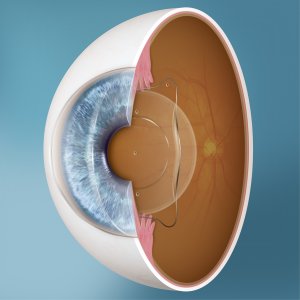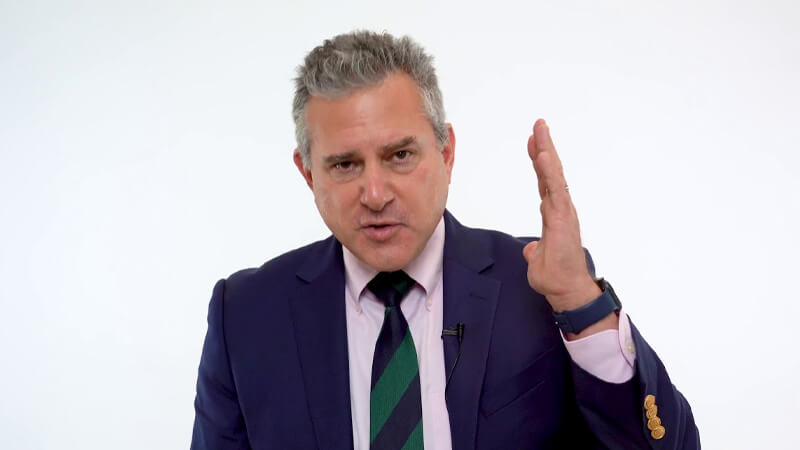What happens if I’m not suitable for Laser Eye Surgery?
While over 97% of patients are suitable and have a prescription that is within the treatment range for laser eye surgery, there will be a small percentage of patients who are not considered to be a safe candidate. This can be due to the prescription, the shape of the eye, or the health of the cornea.
If you fall in to this small number, there are alternative options available to you: phakic intraocular lens implantation, clear lens exchange, or, of course, to continue with glasses and/or contact lenses.
 The Implantable Collamer Lens (ICL) is an extremely small and thin lens implanted inside the eye. The lens sits behind the iris and in front of the natural crystalline lens. In 1997 the ‘V4’ ICL model was approved for use in the UK, and quickly became the go-to treatment option for patients who were not candidates for corneal laser treatment. A few years ago, an updated model of the lens was introduced, which has further improved the safety of these lenses, particularly with respect to the risk of cataract formation by introducing a tiny hole in the centre of the lens. To date, over 1 million ICLs have been implanted worldwide.
The Implantable Collamer Lens (ICL) is an extremely small and thin lens implanted inside the eye. The lens sits behind the iris and in front of the natural crystalline lens. In 1997 the ‘V4’ ICL model was approved for use in the UK, and quickly became the go-to treatment option for patients who were not candidates for corneal laser treatment. A few years ago, an updated model of the lens was introduced, which has further improved the safety of these lenses, particularly with respect to the risk of cataract formation by introducing a tiny hole in the centre of the lens. To date, over 1 million ICLs have been implanted worldwide.In the UK, the lens is available to treat myopia (near-sightedness) from -0.50 to -20.00 D, hyperopia (far-sightedness) from +0.50 D to +10.00 D and astigmatism up to +6.00 D. The lens comes in 4 different sizes to accommodate for a range of eye sizes. If you are considering ICL surgery at London Vision Clinic, this is usually because it is not possible to fully correct your refractive error with laser eye surgery. ICL surgery can be used with laser eye surgery on the surface of the eye to correct any residual refractive error which may not have been fully corrected by the intraocular lens – a technique called Bioptics.
Professor Reinstein explains what sizing methods are used for ICL surgery at London Vision Clinic…

The most advanced method for ICL sizing is to use the Artemis Insight 100 VHF digital ultrasound scanner and directly measure the area inside the eye behind the iris where the lens will be sitting. It seems intuitively obvious that direct measurement of this space inside the eye will provide better information as to which ICL size to choose, than estimating this size from external measurements. It is important that patients be aware of the different sizing methods and ensure that surgeons are using this most advanced method to minimize the chance of complications or needing an ICL lens exchange surgery.
How many appointments will I need?
Your prescription will determine the power of the lens required for ICL surgery, the higher your prescription, the greater the power of the lens required. This determines how many appointments you will need and the pattern of your aftercare.
If you are short-sighted, the lens will have a small hole in the centre to allow for fluid flow around the lens inside the eye. If you are long-sighted, you will need to have a very short laser procedure to create a small hole in the iris for the fluid to flow through. This is done by your surgeon in a consultation room and takes around 1 minute per eye.
How does the process differ from laser eye surgery?

The testing and screening process for ICL surgery consists of the same testing and screening protocols we carry out for laser eye surgery candidates but with the addition of a thorough and full vitreous and retina examination. It is essential to document the health of the peripheral retina, which provides side-vision, with state-of-the art wide-field imaging as certain retinal pathology can affect the success rate of phakic intraocular lens surgery. It is necessary to be evaluated by a retinal specialist to ensure the stability and health of the retina. Treatment of asymptomatic retinal holes or tears may sometimes be required before ICL surgery.
What is the procedure like?
Traditionally, cataract and other lens implant surgery has been performed one eye at a time, with an interval of at least a few days in between eyes. In 2008, the International Society of Bilateral Cataract Surgeons (ISBCS) was formed with the purpose of performing large scale studies to produce the scientific evidence required to compare the risks of performing surgery on both eyes on the same day (known as “immediately sequential bilateral surgery”) or both eyes done on separate days (known as “delayed sequential bilateral surgery”).
The historical justification for delayed sequential bilateral surgery was to minimise the risk of a serious complication occurring in both eyes. Following the work of the ISBCS and the accumulation of a significant number of large-scale scientific studies, it was concluded that treatment of both eyes on the same day does not statistically increase the risk of bilateral serious complications, and in fact, may even reduce the risk of a serious complication occurring in both eyes. In addition, there are significant benefits to performing immediate sequential surgery on the same day such as overall faster outcome and return to daily activities, with fewer visits and less time off work. The safety of performing surgery on both eyes on the same day is maximised by separating the sterile environments between the eyes by a complete change of surgical drapes, gloves, instrumentation, irrigation fluids and medications from different manufacturing batches.
The decision to have both eyes corrected on the same day or on different days is a personal decision that you will make together with your Surgeon. There may be circumstances where your Surgeon will recommend in your individual case that it would be preferable to operate on each eye on separate days. The relevant risks and benefits of immediate versus delayed sequential surgery will be fully discussed with you before a decision is made.

After treatment, you will remain at the clinic for anywhere between 30-60 minutes before receiving a final check which includes eye pressure and lens position review. Eye drops are needed for approximately 1-2 weeks after surgery and you will need to attend a number of follow-up appointments.
What are the benefits of ICLs?
- The procedure is reversible. Should your vision change you can have laser treatment to refine your vision. Alternatively, the lens implants can be replaced or removed if need be.
- Treat higher and more complex prescriptions.
- May be able to treat patients with corneal conditions that might not qualify for laser eye surgery such as keratoconus.
What are the risks of ICLs?
- As ICL surgery is more invasive than laser eye surgery, it carries greater risks than LASIK or ReLEX SMILE. Minor risks include a short-term increase in eye pressure, and inflammation inside the eye.
- Expected side effects are similar to laser eye surgery and include mild irritation and halos at night that usually subside over time.
- Most patients experience only minimal discomfort and are able to go back to work within a few days of the procedure.
Professor Reinstein explains the risks of surgery…

What to expect after ICL surgery
You can return to most normal daily activities the morning after surgery with a few restrictions (e.g. no eye rubbing, swimming, intense physical activity, and avoid dusty or dirty environments). If the eye is stable at 1 week, all restrictions are lifted.
You will be asked to return to the clinic for check-ups to monitor your eyes on a similar schedule to laser eye surgery for the first year. After your 1 year visit, it is important to continue with an eye care provider for annual check-ups including a dilated retinal exam to monitor the positioning of the lens inside the eye and the health of the eye including the back of the cornea (endothelium), iris, lens, and back of the eye (retina).
As with laser eye surgery, there may sometimes be a small prescription remaining after the ICL is implanted. Residual refractive error tends to be very small but can be addressed in a number of ways. After ICL surgery there are no restrictions on the type of glasses or contact lenses a patient can wear. You can also explore laser refractive surgery to treat any residual prescription (assuming you have no corneal conditions which precluded you from laser treatment in the first place).
Professor Reinstein talks through what patients can expect post-operatively with ICL surgery compared to laser eye surgery



